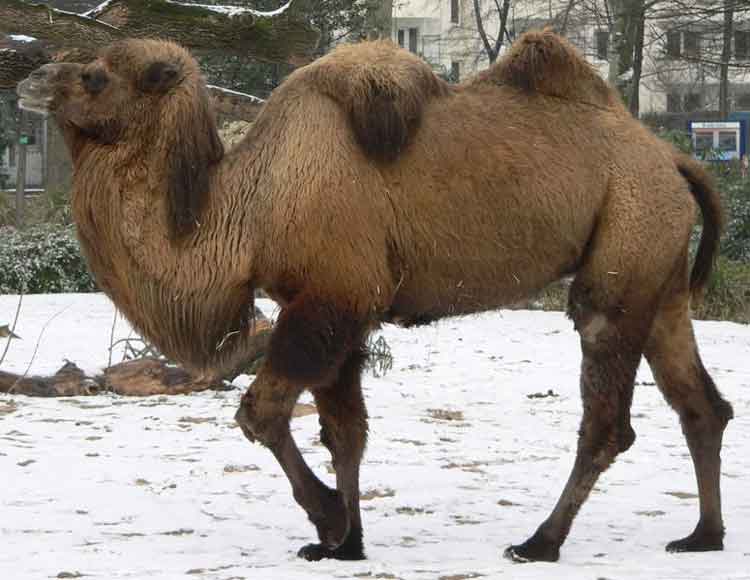
Camelus bactrianus (*)
Cladus: Eukaryota
Supergroup: Opisthokonta
Regnum: Animalia
Subregnum: Eumetazoa
Cladus: Bilateria
Cladus: Nephrozoa
Cladus: Deuterostomia
Phylum: Chordata
Subphylum: Vertebrata
Infraphylum: Gnathostomata
Superclassis: Tetrapoda
Classis: Mammalia
Subclassis: Theria
Infraclassis: Placentalia
Superordo: Cetartiodactyla
Ordo: Artiodactyla
Subordo: Tylopoda
Familia: Camelidae
Genus: Camelus
Species: Camelus bactrianus
Name
Camelus bactrianus Linnaeus, 1758
Vernacular names
Internationalization
Česky: Velbloud dvouhrbý
English: Bactrian Camel
Hrvatski: dvogrba deva
Magyar: kétpúpú teve
Português: Camelo
Slovenčina: ťava
Türkçe: deve
中文: 雙峰駱駝
References
* Camelus bactrianus on Mammal Species of the World.
Mammal Species of the World: A Taxonomic and Geographic Reference, 2 Volume Set edited by Don E. Wilson, DeeAnn M. Reeder
---
The Bactrian camel (Camelus bactrianus) is a large even-toed ungulate native to the steppes of central Asia. It is presently restricted in the wild to remote regions of the Gobi and Taklimakan Deserts of Mongolia and Xinjiang, China. There are a small number wild Bactrian camels still roaming the Mangystau Province of South West Kazakhstan. It is one of the two surviving species of camel.[2] The Bactrian camel has two humps on its back, in contrast to the single-humped Dromedary camel.[3]
Nearly all of the estimated 1.4 million Bactrian camels alive today are domesticated. In October 2002, the estimated 800 remaining in the wild in northwest China and Mongolia were classified as critically endangered on the IUCN Red List of Threatened Species.[1]
Some authorities, notably the IUCN, use the binomial name Camelus ferus for the wild Bactrian camel and reserve Camelus bactrianus for the domesticated form.[1]
History
Head of Bactrian camel
It is thought that the Bactrian camel was domesticated (independently of the dromedary) sometime before 2500 BCE,[4] probably in northern Iran, Northeast Afghanistan,[4] or southwestern Turkestan.[5] The Dromedary camel is believed to have been domesticated between 4000 BCE and 2000 BCE[6] in Arabia. The wild population of Bactrian camels was first described by Nikolai Przhevalsky in the late 19th century. Their name comes from the ancient historical region of Bactria.
Bactrian camels have been the focus of artwork throughout history. For example, western foreigners from the Tarim Basin and elsewhere were depicted in numerous ceramic figurines of the Chinese Tang Dynasty (618–907).
Evolutionary history
As of the 1980s, a complete range of fossils suggests that the first camels appeared in North America about 30 million years ago, had a relatively small body mass and were adapted to warm climates. By the early Pleistocene (about 2 million years ago), they had already evolved into a form similar to the current Bactrian camel and many individuals permanently migrated to the opposite end of the Bering Strait in an abrupt fashion, probably as a response to the advancing ice age. All remaining American populations became extinct about 8,000 years ago.[7]
Bactrian camels in Nubra Valley
Subspecies
There is some evidence that the Bactrian camel can be divided up into different subspecies. In particular, it has been discovered that a population of wild Bactrian camel lives within a part of the Gashun Gobi region of the Gobi Desert. This population is distinct from domesticated herds both in genetic makeup[8] and in behavior.
There are possibly as many as three regions in the genetic makeup that are distinctly different from domesticated camels and there is up to a 3% difference in the base genetic code. However, with so few wild camels, it is unclear what the natural genetic diversity within a population would have been.
Another difference is the ability of these wild camels to drink saltwater slush, although it is not yet certain the camel can extract useful water from it. Domesticated camels do not attempt to drink salt water, though the reason is unknown.
Conservation
The Bactrian camel was identified as one of the top ten "focal species" in 2007 by the Evolutionarily Distinct and Globally Endangered (EDGE) project, which prioritises unique and threatened species for conservation.[9] Fewer than a thousand are thought to survive in the wild and the population is decreasing. A small captive population is kept in Mongolia and China.
Riding Bactrian camel in Nubra Valley, India
Documentaries
* The Story of the Weeping Camel, a 2003 Mongolian documentary/story about a family of nomadic shepherds trying to get a white colt accepted by his mother, who rejected him after a difficult birth.
* Planet Earth: "Deserts", showing footage of wild camels from a two-month trek in the Gobi desert. Includes "diary" section, explaining the difficulties in obtaining the footage.
References
1. ^ a b c Hare, J. (2008). Camelus ferus. In: IUCN 2008. IUCN Red List of Threatened Species. Downloaded on 31 January 2008. Database entry includes justification for why this species is critically endangered
2. ^ Grubb, Peter (16 November 2005). "Order Artiodactyla (pp. 637-722)". In Wilson, Don E., and Reeder, DeeAnn M., eds. Mammal Species of the World: A Taxonomic and Geographic Reference (3rd ed.). Baltimore: Johns Hopkins University Press, 2 vols. (2142 pp.). p. 645. ISBN 978-0-8018-8221-0. OCLC 62265494. http://www.bucknell.edu/msw3/browse.asp?id=14200112.
3. ^ The mnemonic that allows you to remember the correct English word for each is this: "Bactrian" begins with "B", and "Dromedary" begins with "D" -- and "B" on its side has two humps, whilst "D" on its side has only one hump.
4. ^ a b "camel", Encyclopædia Britannica. 2007. Encyclopædia Britannica Online. accessed 11 February 2007.
5. ^ Myths About Camels, The Hatch Report.com.
6. ^ Al-Swailem, et al. Classification of Saudi Arabian camel (Camelus dromedarius) subtypes based on RAPD technique., Journal of Food, Agriculture & Environment, Vol.5 (1) : 143-148. 2007.
7. ^ Emberlin, J. C. Introduction to Ecology (1983), chapter 10.
8. ^ "Wild camels 'genetically unique'". Earth News. BBC. 11:09 GMT, Wednesday, 22 July 2009. http://news.bbc.co.uk/earth/hi/earth_news/newsid_8151000/8151804.stm. Retrieved 22 July 2009.
9. ^ "Protection for 'weirdest' species". BBC. 2007-01-16. http://news.bbc.co.uk/2/hi/science/nature/6263331.stm. Retrieved 2007-05-22.
Retrieved from "http://en.wikipedia.org/"
All text is available under the terms of the GNU Free Documentation License

